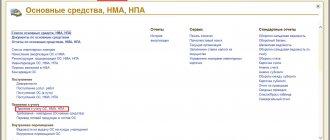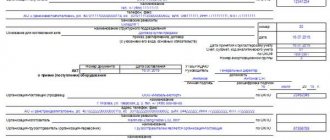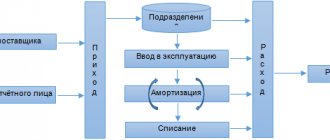VAT deductibility must be restored in the following cases
- When transferring assets - fixed assets, intangible assets, inventories (MPI), property rights as contributions to the authorized capital.
This could be contributions to the authorized capital of business companies, partnerships, or the transfer of real estate to replenish the target capital of a non-profit organization. These can also be investment contributions to investment partnerships and mutual contributions to cooperative mutual funds.
VAT on inventories and property rights should be restored in the amount in which they were taken for deduction, and VAT on fixed assets and intangible assets - in proportion to the residual value of the asset without taking into account revaluation.
It will be useful to read: ⇒ “How to extract VAT from the amount (formula, examples)”
At the receiving party, amounts of recovered VAT are accepted for deduction.
- VAT must be restored in the case where the property, property rights on which VAT was accepted for deduction:
- begin to be used in activities that are not subject to VAT or exempt from VAT;
- begin to be used in activities that are not recognized as sales within the framework of Chapter 21 “Value Added Tax” of the Tax Code of the Russian Federation;
- begin to be used by banks to carry out banking operations;
- when a VAT payer ceases to be a VAT payer or receives an exemption from VAT;
- when the place of their implementation ceases to be the Russian Federation.
In this case, as in the first case, VAT on inventories and property rights must be restored in full, and VAT on fixed assets and intangible assets - in proportion to the residual value of the asset without taking into account revaluation.
Amounts of restored VAT are not accepted for deduction, but are taken into account as part of other expenses under Article 264 of the Tax Code of the Russian Federation.
VAT is restored in the tax period when one of the events listed above occurred, except for the transition to special taxation systems.
When switching to special taxation regimes (except for the Unified Agricultural Tax), the restoration of VAT amounts is carried out in the tax period preceding the date of transition to the special tax regime.
- VAT is restored in case of transfer of an advance (prepayment) for goods, work, services, property rights.
VAT restoration is carried out when goods, works, services, property rights for which an advance payment was previously made are received. This must also be done if there has been a change in the terms of the contract or its termination, resulting in the return of the advance payment.
- VAT is also restored in the event of a decrease in the value of goods, works, services, property rights.
Regardless of the reasons for the decrease in value - both with a decrease in price and with a decrease in the quantity (volume) of transferred goods, property rights, work performed, services rendered.
VAT subject to restoration is calculated on the amount of the difference between the original cost and the cost after reducing the price or quantity of goods, works, services, and property rights sold.
VAT restoration occurs in the tax period to which the earliest date applies:
- The date of the document that formalized the reduction in the cost of goods, works, services, and property rights sold.
- The date the adjustment invoice was received reflecting the change.
- VAT is restored in the event of receiving subsidies from the budget of the Russian Federation to reimburse the costs of paying for goods, work, services, and property rights. A similar procedure applies to reimbursement of tax costs when importing goods into Russia.
Reinstatement is made in the amount previously accepted for deduction.
Recovery occurs during the period in which the subsidy is received.
Amounts of restored VAT are not accepted for deduction or accounting as part of property, but are taken into account as part of other expenses under Article 264 of the Tax Code of the Russian Federation.
Reflection by wiring
Input value added tax is the amount of VAT indicated in expenditure papers as a result of the acquisition of any assets.
During tax recovery operations, postings are used as follows:
| Dt 19 Kt 68 | Restoring the tax on products, works and services |
| Dt 912 Kt 19 | Inclusion of the restored tax amount into the complex of other costs |
When applying VAT on property that is transferred as an investment or contribution, the restored one from the transferor is accepted as part of a complex of financial injections (Dt 58).
The receiving person, according to the letter of the Ministry of Finance dated October 30, 2006 No. 07-05-06/262, in turn, reflects the amount of the restored VAT under article Dt19 Kt 83.
The main documents on the basis of which the entries are reflected are the Accounting Regulations “Accounting for Financial Investments” PBU 19/02, approved by Order of the Ministry of Finance of Russia dated December 10, 2002 No. 126n, and the Accounting Regulations “Accounting for Fixed Assets” PBU 6/ 01, approved by order of the Ministry of Finance of Russia dated March 30, 2001 No. 26n.
Features of restoring VAT amounts for some fixed assets
VAT amounts accepted for deduction on acquired or constructed fixed assets are subject to recovery not for all specified fixed assets, but for those that were used in the following operations:
- when carrying out capital construction by a contractor;
- when purchasing real estate (with the exception of space objects);
- when purchasing on the territory of Russia or importing into the territory of Russia sea, river and aircraft vessels and engines for them;
- when purchasing goods, works, services used in construction and installation work;
- when performing construction and installation work for one’s own needs.
Restoration of such objects occurs in all 5 cases discussed in the previous paragraph, taking into account some features.
VAT restoration: features for fixed assets under Article 171.1 of the Tax Code of the Russian Federation.
VAT restoration is not carried out on fixed assets that are fully depreciated, or more than 15 years have passed since their commissioning.
The amounts of restored VAT are reflected in the VAT Declaration for the 4th quarter of each of the 10 years that have passed after the year in which depreciation on the fixed asset began to be calculated.
Each code, the amount of VAT subject to recovery, is determined as 1/10 of the amount of VAT accepted for deduction, in the corresponding share.
But the corresponding share is determined as the ratio of the amount of goods sold, works, services, property rights not subject to VAT to the total amount of sales for the corresponding year.
The amount of VAT recovery determined in this way for a specific year is taken into account as part of other expenses under Article 264 of the Tax Code of the Russian Federation.
The court of first instance decided the case in favor of the tax authority.
From the Decision of the Arbitration Court of the Saratov Region dated October 11, 2017 in case No. A57-9401/2017, it is clear that the inspectors argued for additional VAT assessment by the fact that the accident occurred due to the fault of the enterprise. The taxpayer, in turn, referring to the court decision in another court case, declared that he was not at fault in the accident.
For your information
From the materials of this other case, it follows that in August 2015, an explosion occurred at the enterprise at the dangerous production facility “Oil Extraction Shop”, which led to the partial destruction of the workshop building, a group accident (11 people), and the death of four people.
During the investigation, it was established that the enterprise operated a hazardous production facility in violation of the requirements of Russian legislation in the field of industrial safety. Based on the results of the inspection, a protocol on an administrative offense was drawn up, the company was found guilty under Part 3 of Art. 9.1 of the Code of Administrative Offenses of the Russian Federation and was fined 700 thousand rubles.
Not agreeing with the imposition of administrative liability, the organization went to court, which decided: the decision to impose an administrative penalty was made by an unauthorized person, which is a significant violation of procedural requirements. Therefore, the court canceled the decision to impose a fine.
Let's return to VAT.
Defending its position, the enterprise, referring to the Law on Production and Consumption Waste, stated that the ferrous scrap metal generated as a result of the accident is not a product specially produced by the company, and its characteristics differ from the originally acquired fixed assets, which were written off from accounting and ceased to exist. as a thing, in connection with which the obligation to restore VAT did not arise.
According to Art. 1 of the said law, scrap and waste of non-ferrous and (or) ferrous metals are products made of non-ferrous and (or) ferrous metals and their alloys that have become unusable or have lost their consumer properties, waste generated during the production of products from non-ferrous and (or) ferrous metals metals and their alloys, as well as irreparable defects that arose during the production of these products.
The company also referred to the fact that the Tax Code of the Russian Federation does not contain a methodology for calculating VAT subject to restoration, and therefore did not agree with the amount of additional tax charged.
The court of first instance did not accept the taxpayer’s arguments, in particular, indicating:
- Ch. 21 of the Tax Code of the Russian Federation does not impose an obligation to restore the amount of VAT when carrying out non-taxable activities in accordance with paragraphs. 25 clause 2 art. 149 of the Tax Code of the Russian Federation, operations for the sale of scrap metal, depending on the presence of taxpayers’ fault in the circumstances of the occurrence of such scrap metal. In addition, the judicial act referred to by the enterprise noted that the decision to impose administrative liability was canceled due to its adoption by an unauthorized person; the court decision does not contain conclusions about the absence of the taxpayer’s fault in the accident; it cannot be considered as evidence on a tax dispute;
- in accordance with paragraph 3 of Art. 38 of the Tax Code of the Russian Federation, a commodity is any property that is sold or intended for sale;
- The procedure for calculating the amount of VAT subject to restoration is provided for in paragraph. 2 pp. 1 clause 3 art. 170 Tax Code of the Russian Federation.
The court came to the conclusion that the amounts of tax previously lawfully accepted for deduction are subject to restoration in relation to the part of the not fully depreciated fixed assets, which is received at the warehouse as scrap and sold using the exemption established by paragraphs. 25 clause 2 art. 149 of the Tax Code of the Russian Federation.
The company appealed the decision of the first instance court to the appellate court.
Other cases of VAT recovery
Despite the fact that all cases of VAT restoration are directly named in Articles 170 and 171.1 of the Tax Code of the Russian Federation, regulatory authorities in their explanations constantly find new reasons for VAT restoration. Each taxpayer has to decide for himself whether to follow such clarifications or not.
After all, if you do not follow, there may be claims on their part, and you will probably have to defend your position in court.
Some cases are shown in Table 1.
Table 1
| No. | An operation for which it is necessary to restore VAT, according to the regulatory authorities | Explanatory document |
| 1 | There was a write-off of illiquid or obsolete goods | Letter of the Ministry of Finance of the Russian Federation dated January 21, 2016 No. 03-03-06/1/1997 |
| 2 | The property was disposed of due to damage | Letter of the Ministry of Finance of the Russian Federation dated March 19, 2015 No. 03-07-11/15015 |
| 3 | Not fully depreciated property was liquidated (except for liquidation as a result of an accident) | Letters from the Ministry of Finance of the Russian Federation dated 04/14/2016 No. 03-07-11/21297, dated 02/17/2016 No. 03-07-11/8736 |
| 4 | Theft of property was recorded | Letters from the Ministry of Finance of the Russian Federation from 04.07.2011 3 03-03-06/1/387, dated 05/19/2010 No. 03-07-11/186 |
| 5 | During the inventory, a shortage of property was recorded | Letters from the Ministry of Finance of the Russian Federation from 04.07.2011 3 03-03-06/1/387, dated 05/19/2010 No. 03-07-11/186 |
At the same time, we must not forget that if there is arbitration practice in which the opposite point of view is expressed, supervisory authorities should be guided in their work by arbitration practice.
An example of arbitration decisions containing conclusions that there is no need to restore VAT in cases of loss of property as a result of theft, damage, etc. or impossibility of further use due to moral or physical wear and tear, the following solutions may serve:
- Decision of the Supreme Arbitration Court of the Russian Federation dated May 19, 2011 N 3943/11
- Decision of the Supreme Arbitration Court of October 23, 2006 N 10652/06.
Accounting entries when restoring VAT
table 2
| Operation | Posting by debit | Loan posting |
| When transferring property as a contribution to the management company | ||
| VAT on property transferred to the authorized capital has been restored | D 19 | K 68.02 |
| The amount of restored VAT is included in the initial cost of the share in the authorized capital (posting is possible - the amount of restored VAT is included in the calculations for payment of the share in the authorized capital) | D 58.01 (D 76) | To 19 (to 10) |
| When switching to simplified tax system | ||
| Recovered VAT on materials in stock | D 19 | K 68.02 |
| The amount of recovered VAT is included in other expenses | D 20 (26) | K 19 |
The Court of Appeal found the tax authority's decision unlawful.
With reference to the Law on Industrial and Consumer Waste, the court came to the conclusion that scrap waste generated from environmental facilities as a result of destruction, dismantling, or accident is not a product specially produced by the enterprise and is not a product that was purchased for the production of products. Sold goods (production waste) differ in their functional and physical characteristics from purchased goods.
The court stated:
- scrap metal is recorded by the enterprise as mixed, without being assigned to any OS;
- There is no calculation method for VAT restoration in the Tax Code of the Russian Federation. The tax authority’s reference to the Letter of the Ministry of Finance of Russia dated 03/18/2011 No. 03‑07‑11/61 was accepted by the court of first instance unlawfully, since according to the Resolution of the Presidium of the Supreme Arbitration Court of the Russian Federation dated 01/16/2007 No. 12547/06, letters from the financial department are not included in the scope of regulatory legal acts applied by the court when considering cases;
- since the enterprise sold not fixed assets, but scrap metal remaining after their destruction, the tax authority had no grounds for applying paragraphs. 2 p. 3 art. 170 Tax Code of the Russian Federation.
The tax authority did not agree with the appeal decision and appealed it in the cassation court.






